Digital Poster
AI for Diagnosis/Prognosis: Neuro I
ISMRM & ISMRT Annual Meeting & Exhibition • 10-15 May 2025 • Honolulu, Hawai'i

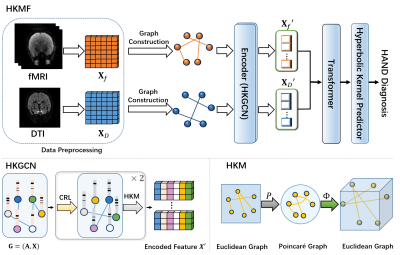 |
Computer Number: 1
1373. HKMF:
Hyperbolic Kernel-based Multimodal Fusion for HIV-Associated
Neurocognitive Disorder Analysis
M. Yang, Q. Wang, Y. Sun, M. Wu, W. Wang, H-J Li, M. Liu
University of North Carolina at Chapel Hill, Chapel Hill, United States
Impact: HKMF utilizes hyperbolic geometry, which is
well-suited for capturing complex hierarchies in
neuroimaging applications. This approach not only enhances
HAND analysis but also can be extended to other medical
imaging applications involving multimodal datasets.
|
|
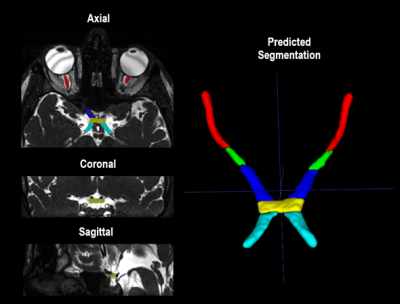 |
Computer Number: 2
1374. AI-driven
segmentation of the anterior visual pathway from high-resolution
MR images: development and clinical validation in MS patients.
A. Diociasi, E. Pravatà, L. Carmisciano, O. C. Kiersnowski,
L. Roccatagliata, A. Chincarini
IRCCS Ospedale Policlinico San Martino, Genova, Italy
Impact: This study demonstrates the clinical potential
of AI-driven segmentation, enhancing the efficiency and
preserving the accuracy, of MRI-based structural integrity
of the anterior visual pathway in multiple sclerosis, thus
paving the way for more consistent and reliable diagnostic
workflows.
|
|
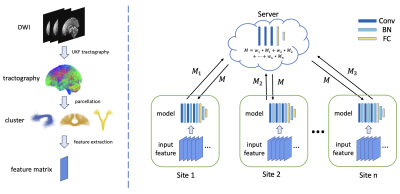 |
Computer Number: 3
1375. Multiple-site
diffusion MRI tractography analysis using federated learning for
brain disease classification
W. Zhang, Y. Li, X. Zhu, L. Zhang, Y. Chen, L. O’Donnell, A.
Cao, S. Li, F. Zhang
University of Electronic Science and Technology of China, Chengdu, China
Impact: This study presents the first deep federated
learning framework to enable multiple-site dMRI tractography
analysis for disease classification. The novel and
site-weighting strategy can effectively accommodate data
distribution differences across sites by demonstrating on
Autism Spectrum Disorder classification.
|
|
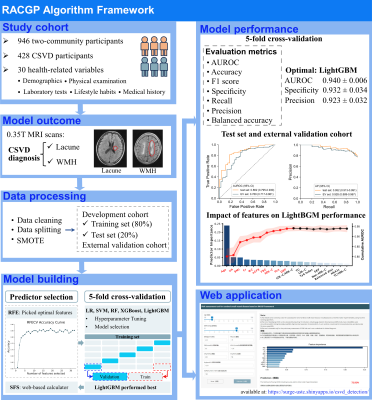 |
Computer Number: 4
1376. Detection
of cerebral small vessel disease in health examination
populations using machine learning
T. Guo, L. Chen, L. Guo, B. Qiu
University of Science and Technology of China, Hefei, China
Impact: Our ML model can identify CSVD patients within
health examination populations in a low-cost manner, showing
potential for CSVD screening.
|
|
 |
Computer Number: 5
1377. Development
a nomogram integrating deep learning-radiomics, pathomics and
Vasari features to predict prognosis of glioblastoma patients
Q. Zhou, J. Zhou
Lanzhou University Second Hospital, Lanzhou, China
Impact: The combined model nomogram, created through
multimodal data integration of clinical characteristics,
Deep learning radiomics signatures, and pathomics features,
enhanced the prognostic risk stratification for patients
with glioblastoma.
|
|
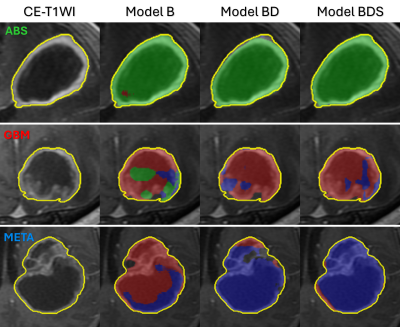 |
Computer Number: 6
1378. Classification
of rim-enhancing brain abscess, glioblastoma, and brain
metastasis using deep learning on multi-modality MRI
C-Y Chang, T-C Chuang, T-Y Huang, P-H Lai
National Sun Yat-Sen University, Kaohsiung, Taiwan
Impact: Our
results demonstrated the value of multi-modality MRI in
differentiation of three rim-enhancing lesions. We also
highlighted the adaptability of our model on 1.5-T and 3-T
data, possibly expanding its clinical use.
|
|
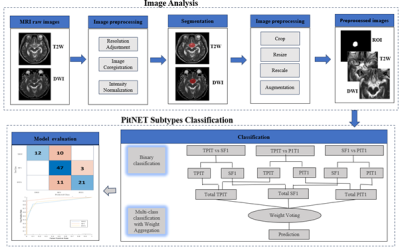 |
Computer Number: 7
1379. A
Deep Learning Ensemble Model for the Classification of Pituitary
Neuroendocrine Tumors Subtypes Using Magnetic Resonance Imaging
E. Ndimulunde, B-F Lin, D-C Lin, C-F Lu
National Yang Ming Chiao Tung University, Taipei City, Taiwan
Impact: Our model provides a non-invasive method for
classifying PitNET subtypes using MRI, potentially enhancing
the accuracy of preoperative diagnosis beyond reliance on
hormone tests alone ultimately improving patient outcomes.
|
|
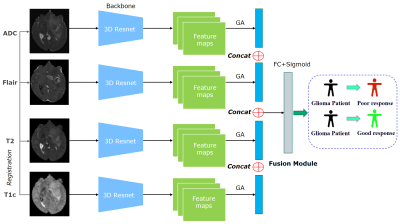 |
Computer Number: 8
1380. Deep
Learning Fusion of Multi-Parametric MRI for Improved Glioma
Prognosis Prediction
Y. Tian, X. Su, X. Liang, D. Ren, Q. Yue
Institute of Research and Clinical Innovations,Neusoft Medical Systems Co., Ltd, Shanghai, China
Impact: The fusion model enhances glioma prognosis
prediction by integrating information from multiple MRI
modalities, achieving higher accuracy than single-modality
approaches. This model can improve personalized treatment
strategies and decision-making.
|
|
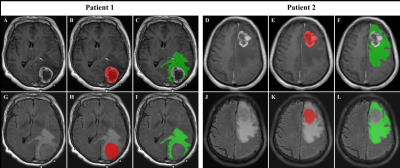 |
Computer Number: 9
1381. Survival
Risk Stratification of 2021 WHO IDH-wt GBM by Multiparametric
MRI Radiomics Model and Exploration of Biological Foundation
L. Yangyang, T. yan
First Hospital of Shanxi Medical University,, Taiyuan, China
Impact: The combined model improves survival risk
stratification in IDH-wt GBM by integrating radiomics and
clinical factors, supporting the guidance of personalized
treatment strategies. The biological foundations may provide
new insights for future therapies.
|
|
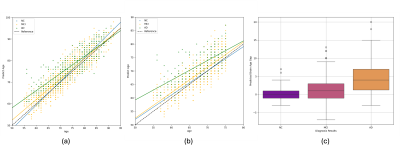 |
Computer Number: 10
1382. Brain
Age Gap Prediction and Application to Alzheimer’s Disease Using
Synthetic T1 and T2 Maps with Deep Learning
P. Xu, S. Qiu, Y. Gao, Z. Deng, S. Madhusoodhanan, P. Sati,
Y. Xie, D. Li
University of California, Los Angeles, Los Angeles, United States
Impact: The integration of T1 and T2 mapping improves
brain age gap prediction and disease classification,
offering a robust, accurate tool for early detection and
monitoring of neurodegenerative diseases.
|
|
|
Computer Number:
1383. WITHDRAWN |
||
 |
Computer Number: 11
1384. Multimodal
MRI-based radiomics model for molecular subtypes prediction and
prognosis evaluation of posterior fossa ependymoma
Y. Li, D. Cheng, J. Li, Z. Zhuo, M. Wu, X. Zhang, Y. Liu
Beijing Tiantan Hospital, Capital Medical University, Beijing, China
Impact: The multimodal MRI-based radiomics model
predicts molecular subtypes of PF-EPNs and enables risk
stratification, provides non-invasive insights for clinical
treatment decisions. This approach facilitates patient
selection for targeted genetic analysis, enhances treatment
precision, and improves monitoring and family counseling.
|
|
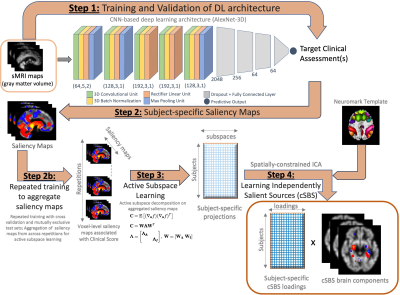 |
Computer Number: 12
1385. Visualizing
sex differences in deep learning models for neuroimaging using
neuroanatomically guided salient source separation
I. Batta, A. Abrol, Y. Bi, V. Calhoun
Center for Translational Research in Neuroimaging and Data Science (TReNDS): Georgia State University, Emory University, Georgia Institute of Technology, Atlanta, United States
Impact: This work aims at utilizing and interpreting the
associative patterns learned by DL models with the goal of
aiding data-driven biomarker development for brain
characeristics and disorders.
|
|
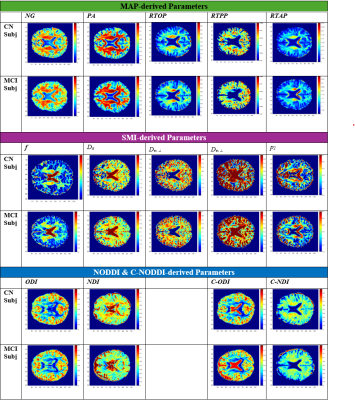 |
Computer Number: 13
1386. Investigating
the Diagnostic Utility of Multi-Shell Diffusion MRI and CSF
Biomarkers for Mild Cognitive Impairment Classification
A. Guo, J. Laporte, K. Singh, Z. Gong, J. Bae, K. Bergeron,
A. De Rouen, N. Zhang, N. Fox, D. Benjamini, M. Bouhrara
National Institutes of Health, Baltimore, United States
Impact: This research highlights diffusion MRI's
potential for classifying prodromal Alzheimer's disease,
paving the way for non-invasive pre-dementia diagnostics. It
additionally provides MRI researchers insights into the
comparative classification performance of various diffusion
MRI models.
|
|
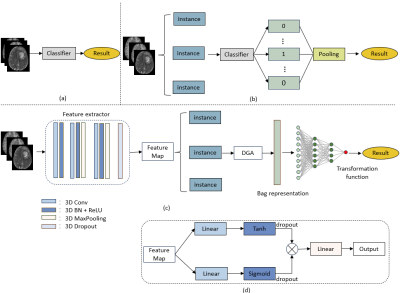 |
Computer Number: 14
1387. Prediction
of IDH Status Using Hierarchical Attention-Based Deep 3D
Multiple Instance Learning
Q. Xie, Y. Liang, Y. Shang, J. Wang, M. Zhang, C. Niu
Xi'an Jiaotong University , Xi'an, China
Impact: The incorporation of a dynamic attention
mechanism in HAB-MIL effectively explores tumor-related
features for IDH prediction, while also fully leveraging
tumor positional information. This enhancement improves the
model's interpretability, providing more valuable support
for clinical diagnosis.
|
|
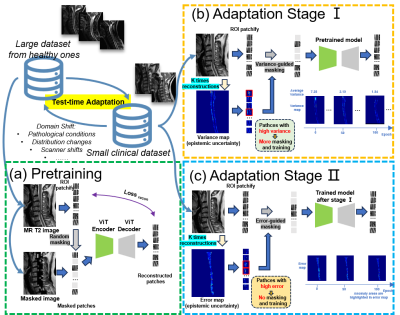 |
Computer Number: 15
1388. Uncertainty-Driven
Self-Supervised Learning with Test-Time Adaptation for Anomaly
Detection of T2 Hyperintensity in Spinal Cord
Q. Zhang, X. Chen, L. Wu, K. Wang, J. Sun, H. Shen
Shanghai Jiao Tong University, Shanghai, China
Impact: This framework advances automated anomaly
detection in spinal MRI, providing clinicians with accurate,
quantifiable, and localized metrics for T2 hyperintensities.
Future researches will further utilize the uncertainty
estimation to improve the anomaly detection performance in
other diseases.
|
The International Society for Magnetic Resonance in Medicine is accredited by the Accreditation Council for Continuing Medical Education to provide continuing medical education for physicians.